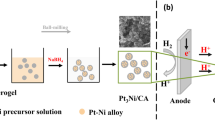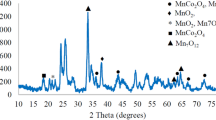Abstract
Carbon-supported copper phthalocyanine (CuPc/C) nanoclusters, as a novel suitable cathode catalyst in polymer electrolyte membrane fuel cells, have been synthesized via a combined solvent impregnation and milling procedure along with high-temperature treatment. For optimizing the electrocatalytic activity of the catalyst obtained, the electrode with varying Nafion ionomer contents in the catalyst layer was screened by cyclic voltammetry and linear sweep voltammetry employing a rotating disk electrode technique to investigate the effect of Nafion ionomer as for alkaline electrolyte. For comparative purposes, electrode with various contents of available anion-ionomer was also investigated. The results revealed that the content of Nafion ionomer can affect the oxygen reduction reaction activity of the CuPc/C catalyst and an optimal content of Nafion ionomer was around 3.5 × 101 μg cm−2, which corresponds well with the electrode prepared using available anion-ionomer. The electrode prepared using Nafion ionomer can produce a comparable performance to that of using available anion-ionomer, giving an onset potential at 0.1 V with a half-wave potential of −0.03 V. Furthermore, Koutechy–Levich analysis showed that the value of electron transfer number is in the range of 3.40 to 3.74 when using electrode with varying Nafion ionomer contents from 2.5 × 101 to 1.6 × 102 μg cm−2. The membrane electrode assembly fabricated with the CuPc/C cathode catalyst with a loading of 3.6 mg cm−2 and a Nafion membrane immersed in 3 M KOH for 48 h produced a power density of 3.8 mW cm−2 at room temperature.







Similar content being viewed by others
References
Colón-Mercado HR, Popov BN (2006) J Power Sources 155:253
Song CJ, Zhang L, Zhang JJ (2006) J Electroanal Chem 293:587
Xu L, Qiao JL, Ding L, Ho LY, Liu LL, Wang HJ (2011) Acta Phys Chim Sin 27:2251
Gong K, Du F, Xia Z, Durstock M, Dai L (2009) Science 323:760
Kim JH, Ishihara A, Mitsushima S, Kamiya N, Ota KI (2007) Electrochim Acta 52:2492
Lee K, Ishihara A, Mitsushima S, Kamiya N, Ota KI (2004) Electrochim Acta 49:3479
Lefevre M, Dodelet JP (2003) Electrochim Acta 48:2749
Baker R, Willkinson DP, Zhang J (2008) Electrochim Acta 53:6906
Cheng R, Li H, Chu D, Wang G (2009) J Phys Chem C 113:20689
Nabae Y, Moriya S, Matsubayashi K, Lyth SM, Malon M, Wu L, Islam NM, Koshigoe Y, Kuroki S, Kakimoto M, Miyata S, Ozaki JI (2010) Carbon 48:2613
Lu Y, Reddy RG (2007) Electrochim Acta 52:2562
Ozaki J, Tanifuji S, Kimura N, Furuichi A, Oya A (2006) Carbon 44:1298
Sehlotho N, Nyokong T (2006) J Electroanal Chem 595:161
Yu EH, Scott K (2004) J Power Sources 137:248
Coutanceau C, Demarconnay L, Lamy C, Léger JM (2006) J Power Sources 156:14
Scott K, Yu E, Vlachogiannopoulos G, Shivare M, Duteanu N (2008) J Power Sources 175:452
Bunazawa H, Yamazaki Y (2008) J Power Sources 182:48
Li YS, Zhao TS, Liang ZX (2009) J Power Sources 190:223
Mo Y, Sarangapani S, Le A, Scherson DA (2002) J Electroanal Chem 538–539:35
Schmidt TJ, Gasteiger HA, Stab GD, Urban PM, Kolb DM, Behm RJ (1998) J Electrochem Soc 145:2354
Shan JN, Pickup PG (2000) Electrochim Acta 46:119
He QG, Yang XF, Ren XM, Koel BE, Ramaswamy N, Mukerjee S, Kostecki R (2011) J Power Sources 196:7404
Ding L, Qiao JL, Dai XF, Zhang J, Zhang JJ, Tian BL (2012) Int J Hydrog Energy 37:14103
Zhu H, Li X, Wang F (2011) Int J Hydrog Energy 36:9151
Sakar A, Manthiram A (2010) J Phys Chem C 114:4725
Wang R, Li H, Feng H, Wang H, Lei Z (2010) J Power Sources 195:1099
Rao CV, Viswanathan B (2007) J Phys Chem C 111:16538
Bard AJ, Faulkner LR (2000) Electrochemical methods, fundamentals and applications, 2nd edn. Wiley, New York
Baturina OA, Wnek GE (2005) Electrochem Solid-State Lett 8:A267
Haug AT, White RE (2000) J Electrochem Soc 147:980
Isaacs M, Aguirre MJ, Toro-Labbé A, Costamagna J, Páez M, Zagal JH (1998) Electrochim Acta 43:1821
Kruusenberg I, Matisen L, Shah Q, Kannan AM, Tammeveski K (2012) Int J Hydrog Energy 37:4406
Acknowledgments
This work is financially supported by the National Natural Science Foundation of China (21173039), Specialized Research Fund for the Doctoral Program of Higher Education, SRFD (20110075110001), Opening Foundation of Zhejing Provincial Top Key Discipline (20110927), and Environmental Protection Engineering Center for Pollution Treatment and Control in Textile Industry, China (20110927). All financial support is gratefully acknowledged.
Author information
Authors and Affiliations
Corresponding author
Rights and permissions
About this article
Cite this article
Ding, L., Xin, Q., Dai, X. et al. Evaluation of carbon-supported copper phthalocyanine (CuPc/C) as a cathode catalyst for fuel cells using Nafion as an electrolyte. Ionics 19, 1415–1422 (2013). https://doi.org/10.1007/s11581-013-0869-2
Received:
Revised:
Accepted:
Published:
Issue Date:
DOI: https://doi.org/10.1007/s11581-013-0869-2




